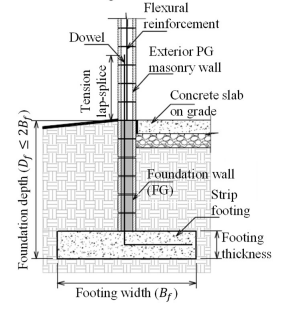Alan Alonso, Mahmoud Elsayed, Rafael Gonzalez, Clayton Pettit, Douglas Tomlinson, and Carlos Cruz-Noguez
i Structural Engineer-in-Training, RCJ Engineers, Edmonton, Canada, aalonsorivers@rjc.ca
ii Ph.D. Candidate, University of Alberta, Edmonton, Canada, mhelsaye@ualberta.ca
iii Ph.D. Candidate, University of Alberta, Edmonton, Canada, rgonzalez@ualberta.ca
iv Assistant Professor, University of Alberta, Edmonton, Canada, cpettit@ualberta.ca
v Associate Professor, University of Alberta, Edmonton, Canada, dtomlinson@ualberta.ca
vi Professor, University of Alberta, Edmonton, Canada, cruznogu@ualberta.ca
ABSTRACT
Load-bearing masonry walls are an effective structural system for single-storey buildings such as warehouses, theatres, community centres, and school gymnasiums. Usually, these types of walls reach a height-to-thickness ratio greater than 30 and are subjected to combined gravity and lateral loads. Due to their perceived vulnerability to second-order effects, North American masonry design standards (CSA S304 and TMS 402/602) set additional design criteria for these walls. In the previous version of CSA S304-14, one of those design requirements was to assume a pinned base condition, neglecting the inherent stiffness provided by the wall-foundation-soil interaction, which affects the strength and stiffness of slender masonry walls. Current versions of CSA S304-24 and TMS 402/602-22 permit using a base support different of a pin for any height-to-thickness ratio by using a more comprehensive analysis. This study aims to determine the out-of-plane flexural response of masonry walls subjected to combined gravity and lateral loads under various height-to-thickness ratios, types of soils, footing geometry, and foundation depth. The parametric analysis showed increased flexural capacity and decreased deflections when the analysis included wall-foundation-soil interaction. The foundation depth and soil capacity were the aspects that most affected the base stiffness. Elastic effective height factors were proposed to account for base stiffness during the design of slender masonry walls for different values of rotational base stiffness. These findings imply that accounting for base stiffness in the analysis and design of slender masonry walls could be an untapped source of strength and stiffness, which may lead to more cost-effective masonry wall designs.
KEYWORDS: Base stiffness, foundation, masonry wall, out-of-plane, slender, soil-structure interaction.
015-Alonso.pdf



